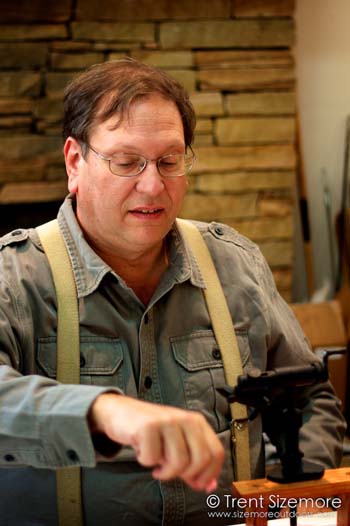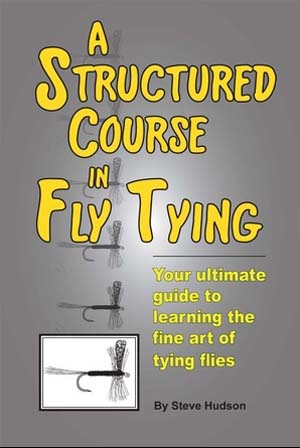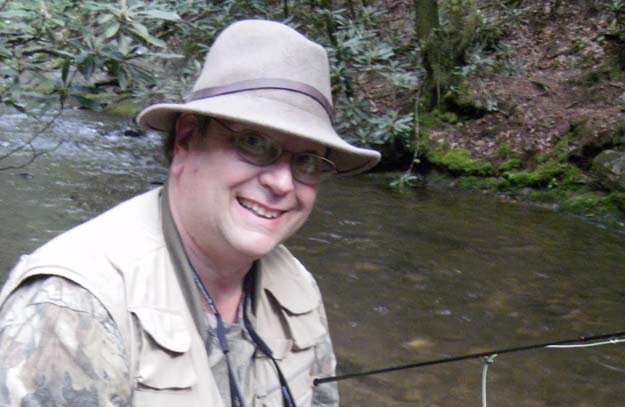There is a Better, Easier Way to Learn the Fine Art of Tying Flies (Series starts Friday, June 23)
by Steve Hudson, Editor-At-Large

Photo credit Trent Sizemore. Steve Hudson tying patterns at the famous Unicoi Outfitters in north Georgia. Steve’s patterns and especially his tying techniques are embraced throughout the Southeastern U. S.
[dropcap]O[/dropcap]ver the last several decades I’ve had the pleasure of teaching many people how to tie flies.
Years ago, I took the traditional “pattern-based” approach. I’d select a pattern and then teach my students how to tie it.
“First, start your thread, then wind to the bend and tie in a suitable hackle feather,” I’d say. “Then dub the thread and wrap a body, then palmer the hackle…”
Along about then is when I got “The Look” – you know, the one that says, “I don’t have a clue what you’re talking about.” Sure, we’d eventually get a fly tied. But it was a whole lot more stressful than it should have been!
Eventually, it dawned on me what was going on
What was happening was a lot like what I sometimes saw in beginning guitar students. They’ll come to me on a Tuesday afternoon and want to be the next Eric Clapton by the following Thursday. Oh, they had the interest and enthusiasm. But they didn’t yet have the basic skills.
That’s what was missing in those fly tying classes too – a focus on learning basic skills first
And so, about 20 years ago, I rethought my approach to teaching fly tying. I realized that even though basic tying skills are no problem for an experienced tyer, they can be major challenges for a beginner – and the best way to learn them is as part of a sequence that takes things one skill at a time.
It soon dawned on me that it might not be a bad idea to toss out the whole notion of pattern-based instruction. In other words, a class would never begin with words like “Today we’ll learn to tie the [fill in the name of your favorite fly].” Instead, the learning would focus on the essential techniques of fly tying.
But folks don’t take tying classes to learn thread management or material handling. People take tying classes to learn how to tie flies. So the next step was to develop a list of practical flies that could be tied at each step along the way, using only the skills and techniques covered to that point. I wanted flies that would give my students an opportunity to practice the techniques they were learning while at the same time giving them flies that they could immediately use on the water.
Eventually, all of those considerations drove the development of what I’ve come to call a “structured” approach to teaching fly tying. It works! And that’s what we’re about to do – embark on a “structured” course in fly tying.
We will start with the most basic things (the ones that experienced tyers often take for granted), working through it together and assuming nothing. Each lesson will focus on one single basic skill which will then be used to tying several different patterns. In the process, you’ll master those skills – and you’ll end up with a bunch of great flies too!
A starting thought

Click on image to buy course book. You will not need the book to follow along each Friday, but it’s a great reference book for your library. Highly recommended.
Writers often conclude introductory remarks with “a closing thought.” But we’re not closing anything out, are we? Instead, we’re opening the door to a grand adventure that will culminate in many years of enjoyment tying flies.
So my starting thought to you is to go for it! Have fun with fly tying! Believe it. There are few things more fun than tying flies – and just wait till you catch that first fish on a fly you tied yourself!
This series is based on the book A STRUCTURED COURSE IN FLY TYING, published by Chattahoochee Media and available from many fly shops, from Amazon, or direct from the author at Chattahoochee Media. You may want to get a copy to reference as you go through the course, for it covers many areas in more detail than we can here.
A complete kit of all materials needed to tie each of the flies covered in this course (as well as additional patterns covered in the book) is also available. It can be purchased directly from Chattahoochee Media by visiting the webstore.
About the author:
Steve Hudson has enjoyed fly tying and fly fishing for many years and has taught thousands of people to tie flies. An award-winning outdoor writer and illustrator, he has written extensively about fly fishing, fly tying, hiking, travel and outdoor recreation, with numerous magazine articles and more than 20 books to his credit. He lives in north Georgia.
NOTE: Featured Image Steve Hudson photo.


